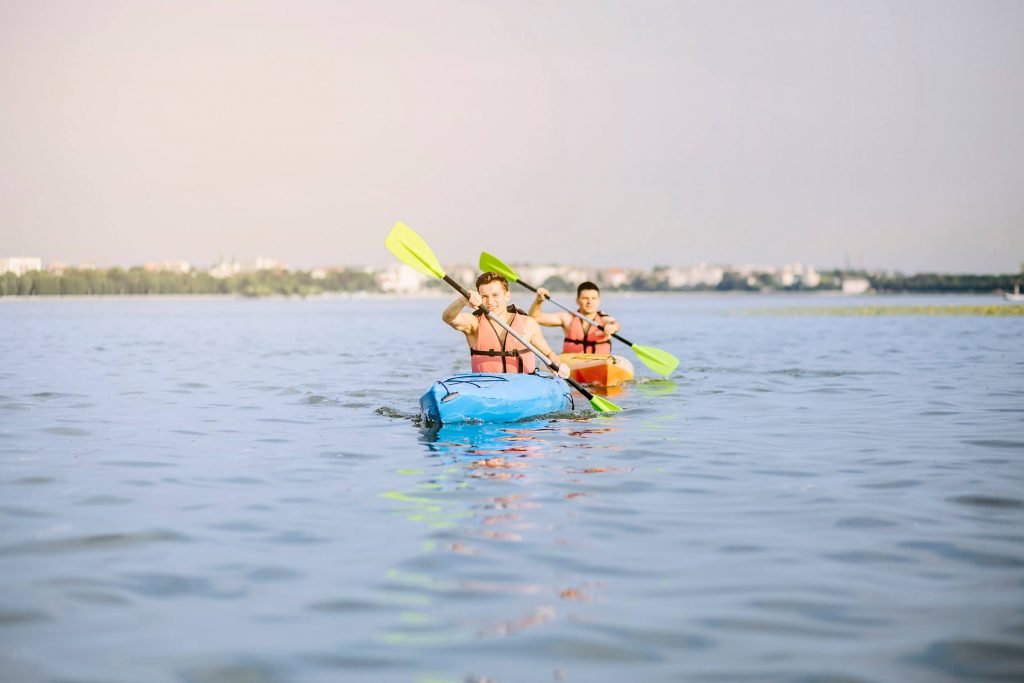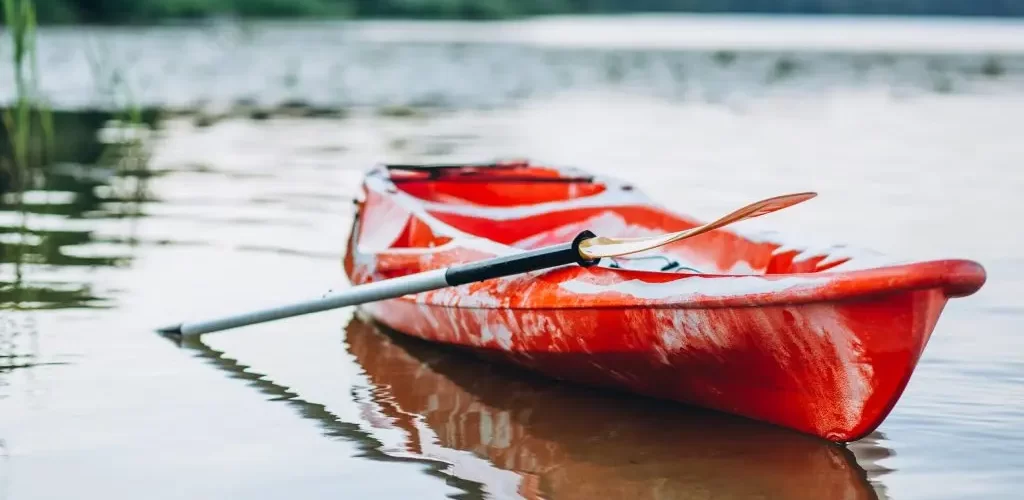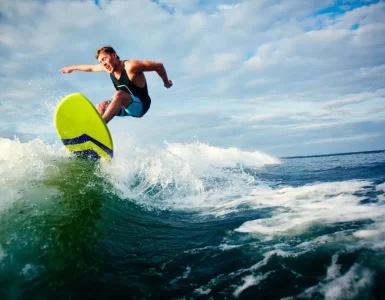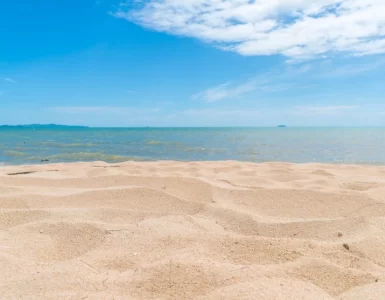Canoe vs kayak, what’s the difference? Which one’s better? And how do you use them? These questions will soon be answered right here.
Now, the debacle between canoe vs kayak is an age-old thing. And we mean that literally, since the history of both water sports date back to thousands of years. With such long histories, you can probably guess that each sport has their own solid arguments to put on the table.
Luckily for you, we’re here to help you choose a side. Does speed matter more than comfort? Are you planning to do this activity alone or with a buddy? These are just a couple of questions that’ll help you figure out if you’re better suited for a canoe or kayak.
Now, for the unknowing outsider, there might not be a clear difference between kayaks and canoes at first glance. But once you dive deeper, there are tangible differences. And we’ll discuss that in just a bit. For a general feel, however, we’d liken canoes to a trusted multi-purpose SUV, and kayaks to sleek and powerful sports cars.
Key Differences Between a Kayak and a Canoe
As there’s so much to learn about each particular water sport, we simply cannot cover everything there is to know about both of them. We can, however, point out the areas in which we can see significant differences between the two. And from what we can tell, there are seven key differences you should know.
Open vs Closed Design
The first — and probably most obvious — difference is in the design of the boat. Canoes are typically much larger and heavier than kayaks. The canoe has an open top and a wider frame, while the kayak has a much sleeker design meant for speed. Kayaks are typically what you’d use for recreational activities that require speed such as open-water paddling or whitewater rapids.
It is, however, important to note that there different types of kayaks and canoes, so the design might vary. For example, a one person canoe would be much smaller than the regular ones. But in general, canoes are 13 to 17 feet in length and sit higher on water compared to kayaks. The sides are tall and the canoe paddler would either be kneeling on slats or sitting on benches.
Typically, kayaks have a more cockpit-like design where the paddler sits inside rather than on top. But there are also “sit-on-top” kayaks that have an open top rather than the usual closed cockpit. The difference between this type of kayak and a regular canoe lies in the size and sleekness of design.
Often, canoes tend to be more traditional, while kayaks can be a bit more versatile. Some kayaks are designed such that they are able to address certain needs. For example, inflatable kayaks are popular for those who want to save storage space. Certain recreational kayaks are also designed to best cater their intended activity.
Comfort and Seating
Comfort can be such a huge factor to your overall performance and even safety when using these watercrafts. So, which is safer: a canoe or kayak?
When it comes to getting in and out, canoes are easier to board and unboard due to its open-top design. It’s as simple as holding on to the side of the canoe or dock to stabilize, stepping on board, and then standing up.
The kayak, however, might be a bit tricky to get into. You’ll have to keep your balance while sliding into the cockpit. However, there are certain kayaks — such as kayaks made for kids — that offer more stability and safety. In general, though, canoes tend to be easier to get on.
When it comes to comfort and stability, some avid kayakers might defend the kayak despite the tough boarding. This is mostly due to the snugness a kayak gives once you’re safely inside. Its size also makes it more comfortable to navigate and control.
Additionally, you can adjust your kayak by adding some back support. This feature is especially helpful for extended day trips.
When it comes to the basic design, however, canoes tend to be more comfortable. The open-top design allows for a greater range of movement, while the kayak’s cockpit design might make the paddler a tad claustrophobic.

Maneuverability and Stability
Are canoes stable? Well, compared to kayaks, yes, they are. Its larger frame offers more stability for the paddler once in the water.
But when it comes to maneuvering, kayaks can be a lot easier to control. They also offer greater speed due to the narrow design. And with the stern and bow curved slightly upwards, less of the hull is in water leading to less resistance.
Kayaks also feature certain equipment that helps in steering such as built-in rudders and skegs. And since kayaks have a lower center of gravity, there is less effort exerted in paddling.
Moving in a straight line is also easier when using a kayak thanks to the double-sided paddles. Because the paddles are designed this way, the paddler wouldn’t need to shift their body to keep the movement in a straight line. All these features allow kayakers to have full reign over their boat without the hassle.
While kayaks are easier to navigate, canoes are more stable. But if the fear of tipping over is what’s stopping you from trying either sport, don’t worry. Modern canoes and kayaks are designed such that they are harder to capsize and more stable. If you still have some reservations, you can opt for a beginner-friendly kayak or canoe to help you ease into stabilizing and maneuvering it.
Amount of Water Splashing
When you’re engaging in a water sport, you’re bound to get wet at some point. But it’s best to minimize your chances.
When in calm waters, a canoe would probably lead to less chances of getting wet. This is because, in a canoe, you’re sitting higher above water compared to when you’re in a kayak. But here’s the thing, water’s aren’t always calm. Oftentimes, the battle is man versus water.
Since the kayak has a more closed design, water is mostly kept out. And even if water does get in, you can easily prevent this by fitting a spray skirt on top of the cockpit. This way the waves would just wash over the kayak instead of getting inside it.
And in the off chance that waves are strong enough to capsize a mostly stable boat, the kayak would be easier to roll upright. For those intending to use a sea kayak, it’s recommended to learn techniques such as the “Eskimo roll” to help get you out of sticky situations in rough waters. The canoe, however, is a much heavier boat and therefore a lot harder to flip upright. And even if you’re able to flip it, it will most likely sink.
Gear Storage
If you’re planning on staying in the water for a prolonged amount of time, you’ll need to bring some stuff with you. Austinkayak has some great kayak gear you can check out if you need some things. However, before you can do that, you need to check out the storage situation in the boats. Now, storage space is a bit of a different story for canoe vs kayak.
With a wider deck and open-top design, storage wouldn’t be a problem for canoe users. You can easily store some coolers and camping equipment in the boat, and they’ll also be easier to reach.
Kayaks, however, have less room since they are typically smaller and narrower. And although a large sea kayak would have sufficient storage space, the location of said storage might be a problem. Since the kayak has a cockpit design, storage is often found below deck, making it difficult to access when in water. And although most kayaks do also come with a smaller dry storage behind the cockpit, it’s not exactly the most accessible thing.
The one advantage of kayak storage, however, is the fact that it’s waterproof. So, even in the rare chance of a capsize, your phone and electronics kept safe in the storage will also be kept dry.
Storage of the boat, however, is a different story. Obviously, storing and transporting a canoe would be much harder since it’s bigger and heavier than a kayak. But there are some equipment, such as canoe or kayak racks for trucks, that’ll help you load up these boats.
How To Use The Watercraft
Canoes and kayaks can both be used in different types of activities. But there are indeed certain benefits in using one over the other, depending on the activity.
We’ve mentioned how canoes have a much better storage option compared to kayaks. So the canoe would be the more ideal boat to use when just chilling on a lake with friends. You can fit more people in and you’ll have enough space for some refreshing beverages in the cooler.
That’s not to say you can’t bring a buddy along when you’re on a kayak. You can check out some two-person tandem kayaks if you’re planning to go kayaking with a friend or a significant other. It’ll definitely be a fun bonding experience to bring you two closer.
If you’re looking for something more adventurous, then the kayak can give you lots of options. You can try sea kayaking, whitewater rafting, or even deep-water fishing. For ocean expeditions, the kayak is your best bet.
For touring, either one is a good option. However, you have to consider the type of tour you plan to go on. If it’s on open waters, then a sea kayak would be better suited for the job. But if you want a relaxing tour along the river, then you should go for the canoe.
Traditionally, canoes are the preferred boat for those intending to fish. However, pedal kayaks for fishing have also become quite popular. These kayaks use foot pedals instead of paddles so that the hands can focus on holding the fishing rod. And when your hands get tired, these kayaks also come with rod holders.
How To Paddle The Watercraft
Canoes may be generally more comfortable than kayaks, but that doesn’t put paddling into the equation. Because the canoe is a larger and heavier boat, you’ll need to exert more effort when paddling. Thankfully, a canoe can house more than one person, so you’ll get some help in paddling. The learning curve, however, tends to be steeper at first for canoes compared to kayaks.
Canoe paddles are shorter than kayak paddles and only have one blade at the end. When paddling a canoe, paddlers would have to grip with one hand in the middle and the other hand at the end. The hand in the middle gives more power in the stroke, while the hand at the end allows for control. To keep the canoe in a straight line, two paddlers must use alternate strokes, with one paddle on each side.
For kayakers, paddling might be easier. Typically, there is a single paddler with one paddle that has a blade on each end. The kayaker would grip the paddle in the middle with both hands and dip the blades alternately. Additionally, the design of the kayak paddles allows for less water resistance, making it easier to use.
Kayak Pros and Cons
Pros
- Maneuvering the kayak is easier and quicker to do
- More stable and easier to control in open water and waves
- Kayaks offer versatility in design depending on the intended use or activity
- Waterproof gear storage
- Able to roll upright when tipped using safety techniques
- Inflatable and folding kayaks are easier to transport
Cons
- Closer to the water and higher chance of getting wet
- Closed cockpit design limits movement
- Advanced techniques are harder to learn
- Less stable on calm waters compared to canoes
Canoe Pros and Cons
Pros
- Open-top design and more space makes it more comfortable
- Great for tandem activities with a friend
- High walls prevent water from getting in while on calm waters
- Sufficient storage space for larger gear and coolers
- More difficult to capsize due to wider beam and hull
- Best for relaxing activities on the water
Cons
- More difficult to paddle when riding solo
- More difficult to move in a straight line
- More difficult to maneuver
- Not easy to transport
- A capsized canoe will sink
- Storage is not waterproof
Final Thoughts: Which one is better?
In the great canoe vs kayak debacle, there is no definite answer. Your choice ultimately comes down to what type of experience you want to get out from this. For a more relaxing water tour with friends, the canoe is the better choice. On the other hand, if a solo adventure is what you’re looking for, the kayak will be your friend.
If you believe the kayak is the better fit for you, then that’s great. We’ve got some helpful lists on the best inflatable kayaks, best sea kayaks, best sit-on-top kayaks, and much more just for you.
But, whichever is your winner, make sure to get the best experience out of it. And don’t forget to stay safe.




